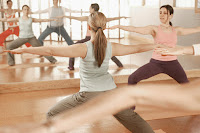By
Faye Martins
As a Yoga instructor, the ability to calm children
in our classes seems magical at times, but even more rewarding is the feedback
from parents about better grades in school and improved behavior at home.
A
yogic practice brings great benefits to body, mind, and spirit. Everyone can practice;
there are no special qualifications or requirements to begin and no philosophical
path you must follow. Children in particular can benefit greatly from the
practice of yoga. While much of the world, even for children, has become
hyper-competitive and highly regimented, the yoga studio is a sanctuary where
every student can slow down, breathe, and move at their own pace.
Expectations for children are especially high these days, with full-time schooling starting at ever younger ages and organized activities taking up much of what was once free time. Many children have trouble sitting quietly and paying attention for such long periods of time, which can lead to acting out and behavioral issues. Yoga helps kids learn to calm themselves and how to focus when they need to. Kids also need time to play, to explore, to burn off energy, and to just “be”, and classes are a wonderful place to do all of these things, and more.
For some children, school and extracurricular activities are difficult and sometimes frightening situations and they struggle to find a place of peace under such circumstances. A yoga teacher should encourage an atmosphere that is by nature noncompetitive and nonjudgmental; there are no tests, no cliques, and a child's only competition is to improve gradually. Yoga class can be a safe haven for kids who have felt left behind socially or academically, and the feelings of success and accomplishment that they get from participating in classes will carry on to all aspects of their life.
Sedentary pastimes such as television watching and video gaming are the preferred activities for many children. Kids generally overflow with of energy and need physical activity to get that out of their system. Yoga class is a great way to get kids engaged in something that doesn’t require the television or computer, and regular physical exercise will free them of the pent-up energies that are so difficult for kids (and parents) to manage.
Children need to exercise both their mind and their body to stay calm, in balance, and focus on building skills for life. It takes some practice to know how to make the right choices, but with any luck, children who learn these skills early on will grow up to be adults who are healthier and more at peace and yoga can play an important part in this process.
Expectations for children are especially high these days, with full-time schooling starting at ever younger ages and organized activities taking up much of what was once free time. Many children have trouble sitting quietly and paying attention for such long periods of time, which can lead to acting out and behavioral issues. Yoga helps kids learn to calm themselves and how to focus when they need to. Kids also need time to play, to explore, to burn off energy, and to just “be”, and classes are a wonderful place to do all of these things, and more.
For some children, school and extracurricular activities are difficult and sometimes frightening situations and they struggle to find a place of peace under such circumstances. A yoga teacher should encourage an atmosphere that is by nature noncompetitive and nonjudgmental; there are no tests, no cliques, and a child's only competition is to improve gradually. Yoga class can be a safe haven for kids who have felt left behind socially or academically, and the feelings of success and accomplishment that they get from participating in classes will carry on to all aspects of their life.
Sedentary pastimes such as television watching and video gaming are the preferred activities for many children. Kids generally overflow with of energy and need physical activity to get that out of their system. Yoga class is a great way to get kids engaged in something that doesn’t require the television or computer, and regular physical exercise will free them of the pent-up energies that are so difficult for kids (and parents) to manage.
Children need to exercise both their mind and their body to stay calm, in balance, and focus on building skills for life. It takes some practice to know how to make the right choices, but with any luck, children who learn these skills early on will grow up to be adults who are healthier and more at peace and yoga can play an important part in this process.
© Copyright 2012 –
Aura Wellness Center – Publications Division
To see our selection
of Yoga teacher training courses, please visit the following link.
Free Report, Newsletter,
Videos, Podcasts, and e-Book, “Yoga in Practice.”
If you
are a Yoga Teacher, studio manager, blogger, e-zine, or website publisher, and
are in need of quality content, please feel free to use my blog entries
(articles). Please be sure to reprint each article, as is, including the
resource box above. Namaste!







